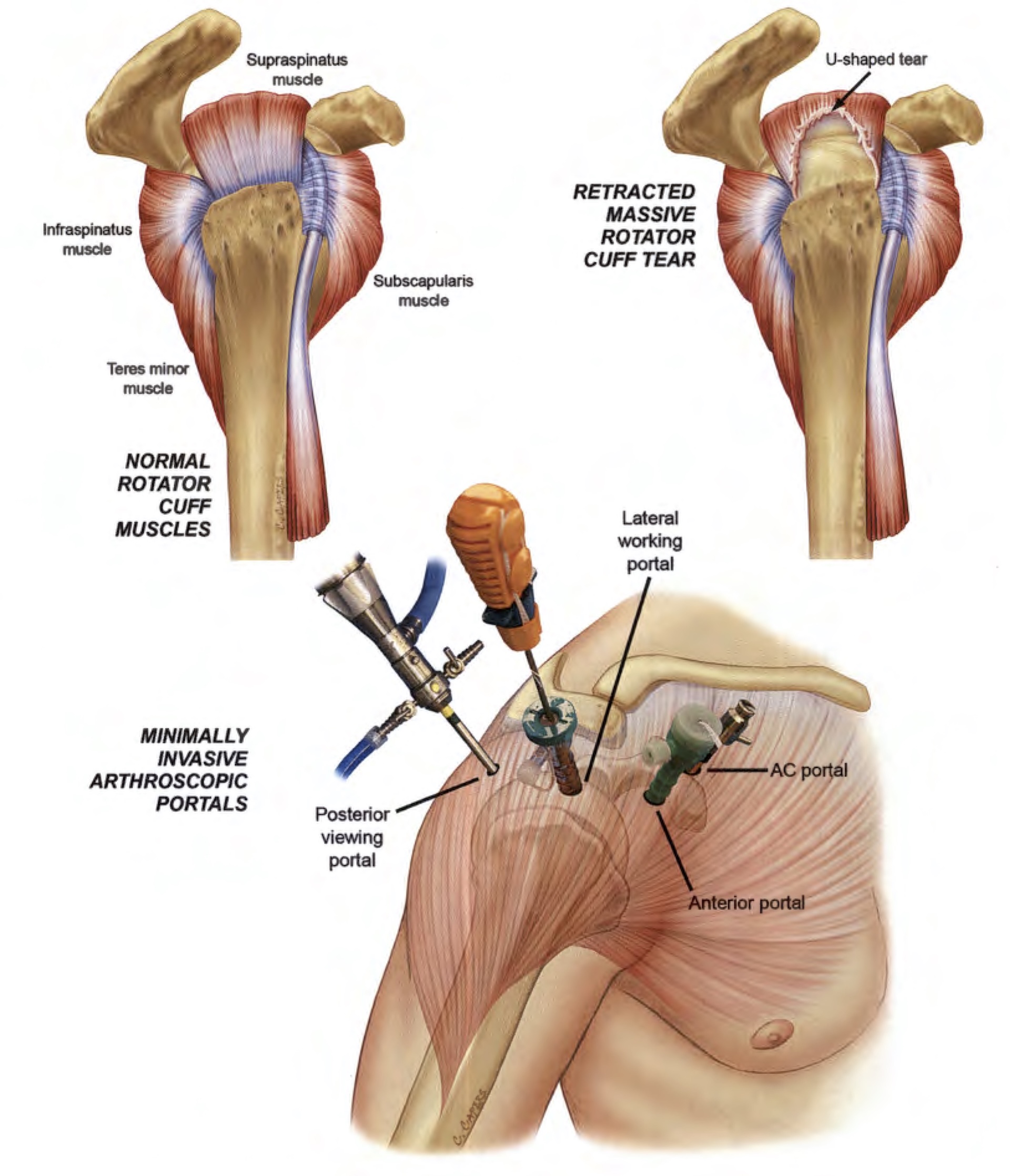Rotator cuff pain is most often felt in the shoulder, typically presenting as a deep ache. It can also radiate down the arm, making certain movements challenging. In this post, we’ll explain where rotator cuff pain is usually experienced, along with common symptoms, causes, and treatment options.
Key Takeaways
- The rotator cuff is essential for shoulder stability and movement, made up of four key muscles and their tendons.
- Rotator cuff pain often presents as a deep ache and can be accompanied by sharp pain, weakness, and a reduced range of motion.
- Treatment options for rotator cuff injuries include conservative approaches like physical therapy and rest, while surgical interventions are considered for some injuries.
Understanding the Rotator Cuff
The rotator cuff is a group of muscles and tendons that play an essential role in shoulder stability and movement. These muscles and their associated tendons secure the shoulder and arm within the shoulder joint, allowing for a wide range of movements. From lifting your arm to rotating it, the rotator cuff is central to almost every shoulder movement you make.

However, the rotator cuff is also vulnerable to injuries. Rotator cuff tears, whether partial or full-thickness, can impair shoulder stability and function, leading to discomfort and loss of mobility.
Characteristics of Rotator Cuff Pain
Rotator cuff pain is frequently described as a deep, dull ache within the shoulder joint. It may worsen at night, making it difficult to find a comfortable sleeping position.
However, the pain can also present sharply during certain movements. It can be particularly pronounced when you lift your arm, reach behind your back, or perform any activity that requires shoulder rotation.
While symptoms can vary, addressing pain early can be important to maintain comfort.
Associated Symptoms with Rotator Cuff Injuries
In addition to shoulder pain, other symptoms are associated with rotator cuff injuries. One of the most noticeable is shoulder weakness, which can make simple tasks like lifting objects or reaching overhead challenging.
Another common symptom is a restricted range of motion. Individuals with rotator cuff injuries may find it difficult to raise their arms or perform movements that involve reaching behind their back. These limitations can affect daily activities and overall quality of life.
Not all rotator cuff injuries show clear symptoms. Some individuals may have asymptomatic tears, meaning they experience little to no pain or weakness.
Causes of Rotator Cuff Pain
Rotator cuff injuries often stem from repetitive overhead movements. These motions are common in sports like tennis or baseball and can lead to tendon irritation or tears.
Traumatic events such as falls, heavy lifting, or forceful throwing can also lead to rotator cuff tears. Chronic conditions are another possible cause of rotator cuff pain. Over time, tendons may degenerate, often due to overuse or aging. This gradual wear and tear may weaken the tendons, making them more susceptible to tears and other injuries.
Diagnosing Rotator Cuff Issues
Diagnosis typically begins with a physical examination. During the exam, your doctor will assess different parts of the shoulder and test muscle strength to identify any weaknesses or abnormalities.
Imaging tests also play an important role in confirming the diagnosis:
- X-rays can help identify accompanying bone-related issues.
- Ultrasounds provide real-time images of the shoulder’s soft tissues.
- Magnetic resonance imaging (MRI) scans offer highly detailed images of soft tissues, helpful in assessing tear severity.
This comprehensive process can help provide an accurate diagnosis and guide an appropriate treatment plan.
Treatment Options for Rotator Cuff Pain
The first line of treatment for rotator cuff pain is typically non-surgical, including physical therapy, rest, and medication. However, if the tear is severe or if conservative approaches fail to provide adequate relief, surgery may be indicated.
Non-surgical Treatments
The initial approach to managing rotator cuff injuries involves controlling pain, improving range of motion, and strengthening the shoulder muscles. Physical therapy is generally the cornerstone of this treatment strategy, involving exercises designed to enhance shoulder stability and function. Patients are typically encouraged to continue using their shoulder in a safe way during treatment, as complete stillness can lead to stiffness and further weakness.
Other non-surgical treatment options may include rest, nonsteroidal anti-inflammatory drugs (NSAIDs), or corticosteroid injections for short-term pain relief.
Surgical Interventions
If non-surgical measures are unsuccessful or the tear is severe, surgery may be recommended. Two primary surgical options are commonly used: arthroscopic surgery, a minimally invasive technique, and open surgery.
Procedures for partial tears may involve removing inflamed tissue or bone spurs to reduce tendon pressure. Complete tears may require reattaching the tendon to the bone, followed by a structured rehabilitation plan.

Preventing Rotator Cuff Injuries
Preventive strategies can help reduce the risk of a rotator cuff injury. Strengthening the shoulder muscles can enhance overall shoulder function and reduce injury risk. Incorporating specific exercises like shoulder blade squeezes into your routine can improve shoulder stability and support rotator cuff health.
Proper posture and technique during overhead activities are essential in reducing unnecessary stress on the rotator cuff. Additionally, gradually increasing exercise intensity allows the shoulder muscles to adapt and recover, lowering the risk of injury.
Avoiding repetitive overhead movements and taking regular breaks during activities that strain the shoulder can also help prevent rotator cuff injuries. By taking these measures, you can minimize the likelihood of experiencing a rotator cuff injury.
Summary
Rotator cuff injuries can affect nearly every shoulder movement, making daily activities more difficult. Early recognition of symptoms like aching, weakness, or pain with overhead motion can lead to prompt diagnosis. Some cases may improve with nonsurgical treatments, while more severe tears may require surgery. Preventative measures and regular conditioning can help maintain long-term shoulder health.
Frequently Asked Questions
What are the common symptoms of a rotator cuff tear?
The common symptoms of a rotator cuff tear are shoulder pain, typically presenting as a dull ache, weakness, and difficulty with overhead movements.
How is a rotator cuff tear diagnosed?
A rotator cuff tear is often diagnosed through a combination of a physical examination and imaging to evaluate the injury and any related issues. This comprehensive approach helps ensure an accurate assessment of the condition.
What non-surgical treatments are available for rotator cuff pain?
Non-surgical treatments for rotator cuff pain primarily involve physical therapy, rest, and medications to help alleviate pain and enhance function.
When is surgery necessary for a rotator cuff tear?
Surgery may be recommended for significant rotator cuff tears that result in ongoing pain and functional limitations. An experienced orthopedic surgeon can help guide the most appropriate treatment plan.
How can I prevent rotator cuff injuries?
To reduce your risk of rotator cuff injuries, focus on strengthening your shoulder muscles, maintaining good posture, and avoiding repetitive overhead movements. Incorporating specific exercises and gradually increasing activity intensity can also be beneficial.



